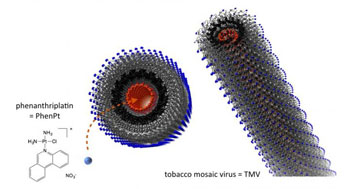Tobacco Mosaic Virus Nanoparticle Delivery System Increases Potency of Experimental Anticancer Drug
By LabMedica International staff writers
Posted on 20 Jun 2016
A candidate anticancer drug was found to be considerably more potent than standard treatments and this potency was further increased in a mouse model when the drug was delivered by a tobacco mosaic virus (TMV)-based transport system.Posted on 20 Jun 2016
The experimental anticancer drug candidate phenanthriplatin (cis-[Pt(NH3)2Cl(phenanthridine)](NO3)), is a cationic monofunctional DNA-binding platinum(II) compound with unusual potency and cellular response profiles that was developed at the Massachusetts Institute of Technology (Cambridge, USA).

Image: When packaged inside tobacco mosaic virus nanoparticles, phenanthriplatin is delivered to tumors, where it was shown to be more effective in vivo than an approved platin (Photo courtesy of Case Western Reserve University).
Despite being up to 40 times more potent than traditional platin agents when tested directly against cancer cells growing in culture, the compound performed no better than standard platins in mouse models. To enhance the delivery of the drug investigators at Case Western Reserve University (Cleveland, OH, USA) used tobacco mosaic virus (TMV) as a delivery system (designated PhenPt-TMV). TMV forms hollow nanotubes with a polyanionic interior surface. The investigators capitalized on this native structure to develop a one-step phenanthriplatin loading protocol.
They reported in the April 26, 2016, issue of the journal ACS Nano that phenanthriplatin was released from the carrier when subjected to the acidic environment with tumor cells. In vivo tumor delivery and efficacy were confirmed by using a mouse model of triple negative breast cancer. Tumors treated with PhenPt-TMV were four times smaller than tumors treated with free phenanthriplatin or cisplatin, owing to increased accumulation of phenanthriplatin within the tumor tissue.
"We may have found the perfect carrier for this particular drug candidate," said senior author Dr. Nicole Steinmetz, assistant professor of biomedical engineering at Case Western Reserve University. "The long, thin tobacco mosaic virus nanoparticles are naturals for delivering the drug candidate into tumors. Phenanthriplatin is about one nanometer across and, when treated with silver nitrate, has a strong positive charge. It readily enters and binds to the central lining. Inside tumors, the nanoparticles gather inside the lysosomal compartments of cancer cells, where they are, in essence, digested. The pH is much lower than in the circulating blood. The shell deteriorates and releases phenanthriplatin."
Related Links:
Massachusetts Institute of Technology
Case Western Reserve University














